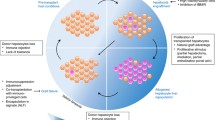Summary.
Within the past 30 years hepatocyte transplantation has been developed in rodents for the cure of acute and chronic liver failure. Organ shortage and the enormous costs of orthotopic liver transplantation have promoted intensive research in transplantation of isolated hepatocytes. Transplanted syngeneic hepatocytes survive indefinitively in rodents, allowing correction of various inherited liver enzyme defects or enhancing recipient survival in experimentally induced acute liver failure. The clinical application of hepatocyte transplantation has been recently demonstrated in a young patient suffering from Crigler-Najjar syndrome type I, with successful long-term survival of allogeneic hepatocytes. This review reports the historical development and the published data on experimental and clinical hepatocyte transplantation.
Zusammenfassung.
Nach dem Vorbild der Übertragung gesunder Inselzellen hat sich in den letzten 30 Jahren die hepatocelluläre Transplantation zur Behandlung des akuten und chronischen Leberversagens entwickelt. Erst die Organknappheit und der große finanzielle und logistische Aufwand der orthotopen Organtransplantation haben zu einem neuen Aufleben des Wissenschaftszweigs geführt, der sich mit der Transplantation isolierter gesunder Leberzellen befaßt. Syngene Leberzellen lassen sich nach Transplantation im Tiermodell auf unbestimmte Zeit im Emfängerorganismus nachweisen. Sie ermöglichen eine Korrektur verschiedener angeborener Stoffwechselerkrankungen der Leber und eine verbesserte Überlebensrate beim akuten Leberversagen. Der in jüngster Zeit berichtete Erfolg beim klinischen Einsatz der Leberzelltransplantation zur Behandlung des Crigler-Najjar-Syndroms Typ I zeigt eine erfolgreiche Übertragung dieser Transplantationstechnik auf den Menschen. Während die theoretischen Vorteile der Leberzelltransplantation evident sind, wird sich deren klinische Anwendung am Goldstandard des orthotopen Organersatzes messen müssen. In der Übersichtsarbeit werden die geschichtliche Entwicklung und der heutige Stand der tierexperimentellen und klinischen Anwendung dargestellt und diskutiert.
Similar content being viewed by others
Author information
Authors and Affiliations
Rights and permissions
About this article
Cite this article
Markus, P., Becker, H. Hepatocelluläre Transplantation – von den Anfängen bis zum klinischen Einsatz. Chirurg 70, 162–168 (1999). https://doi.org/10.1007/PL00002589
Published:
Issue Date:
DOI: https://doi.org/10.1007/PL00002589




